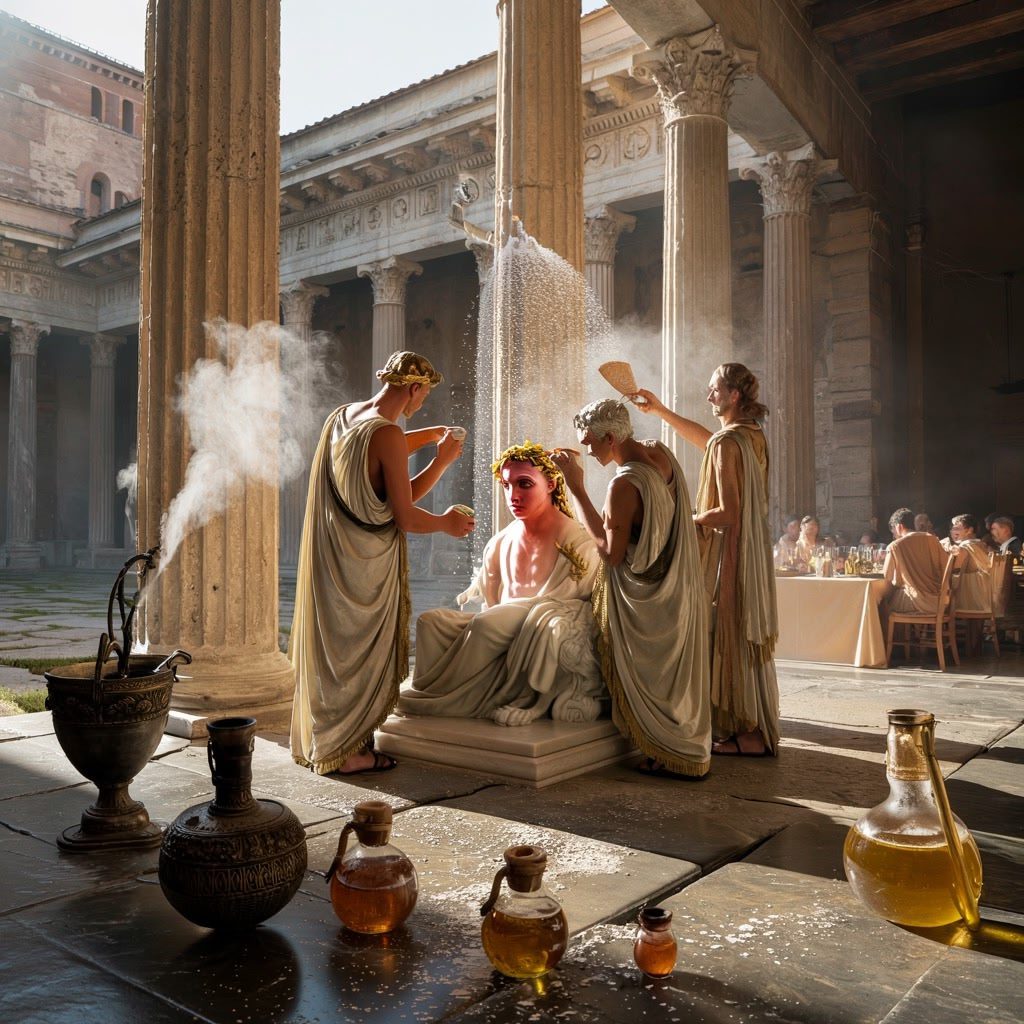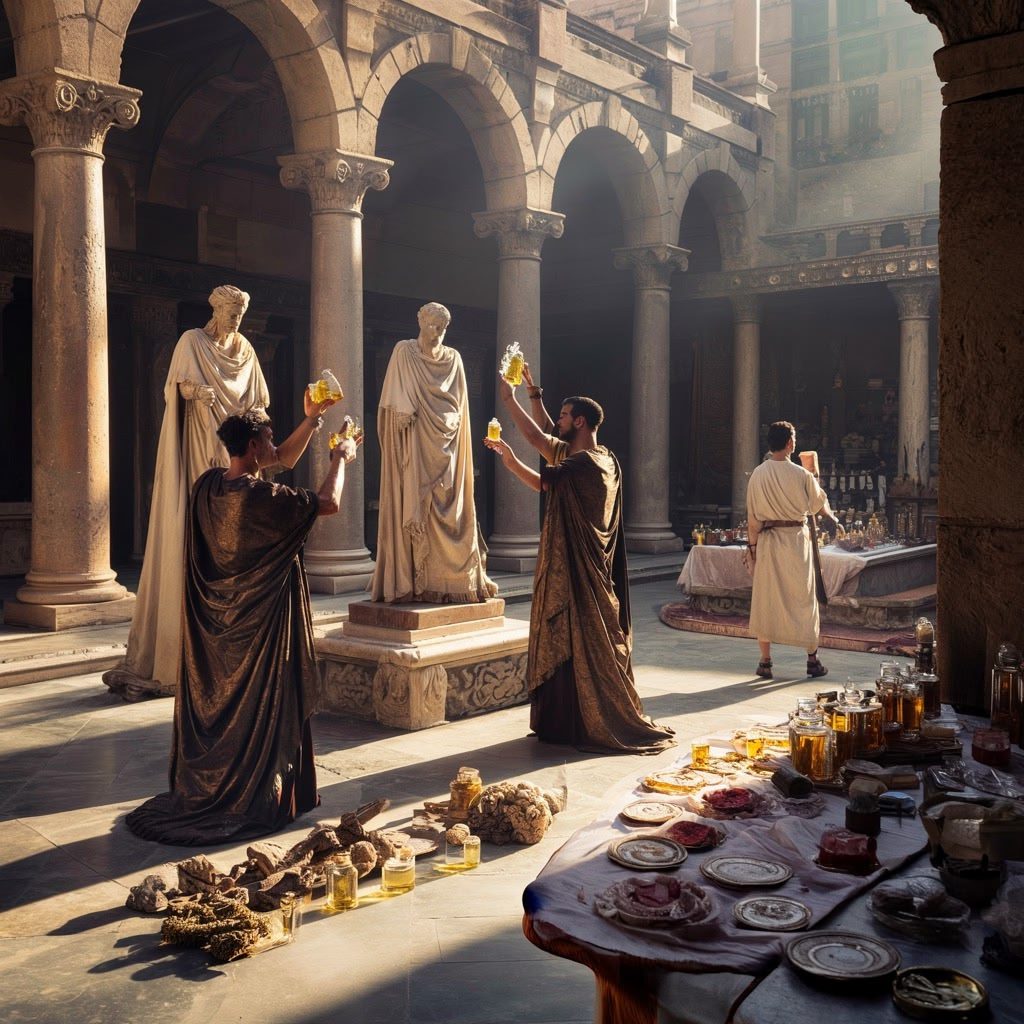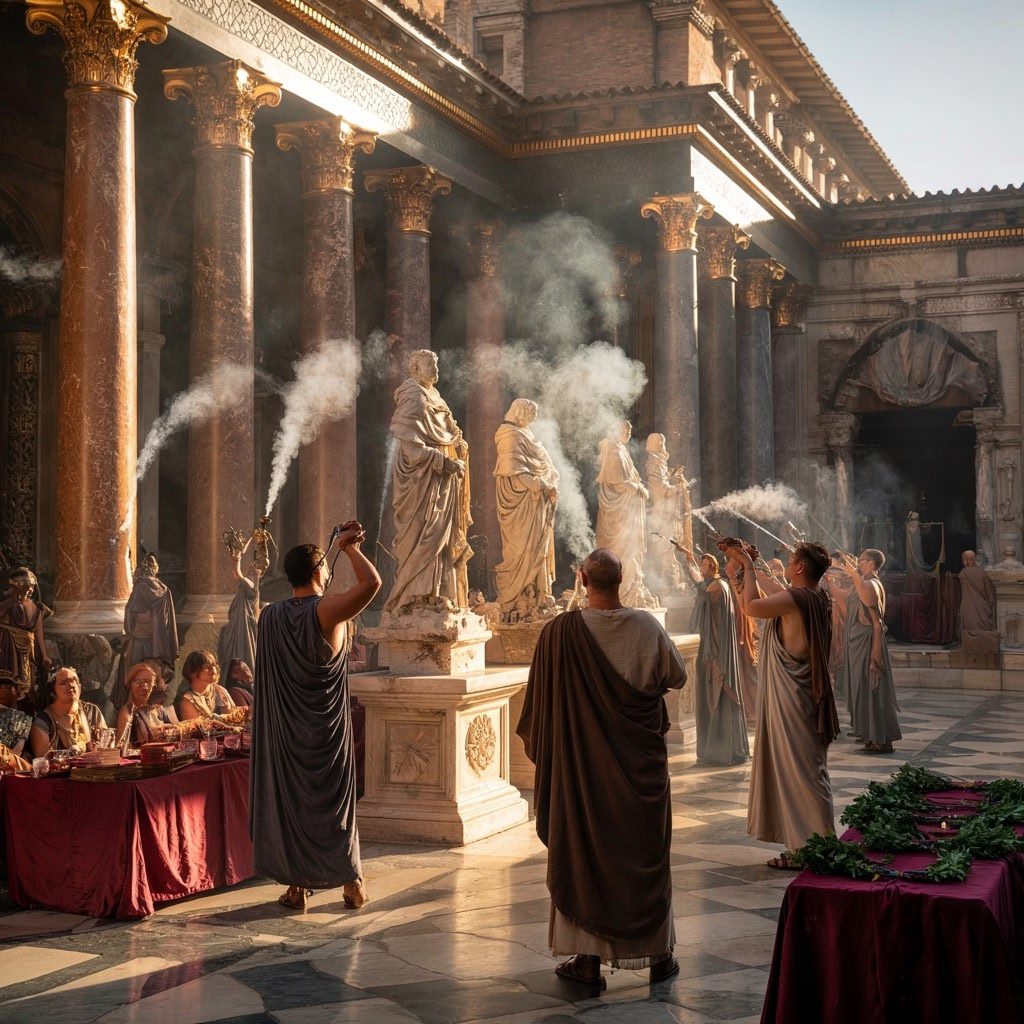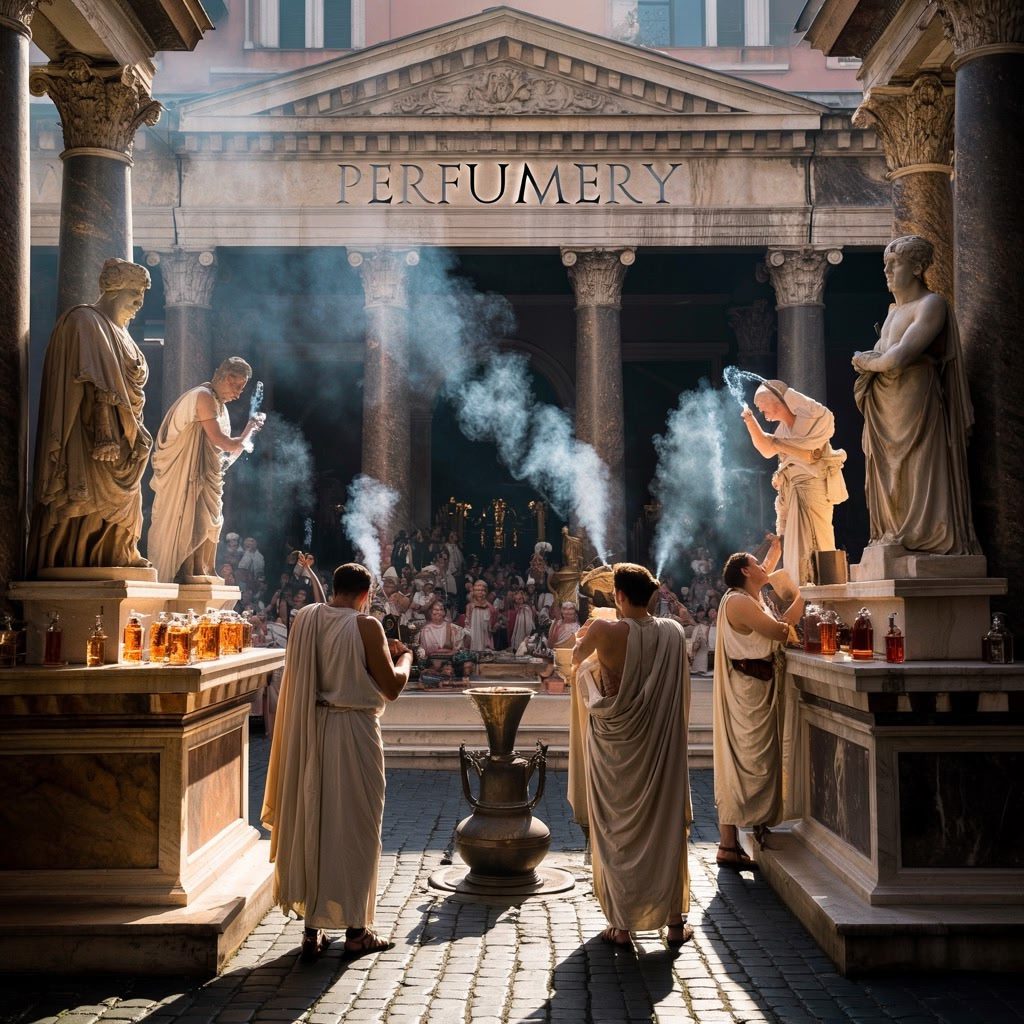Perfume held a unique and powerful place in ancient Rome. Its presence extended far beyond simple fragrance, weaving deeply into the fabric of Roman culture. In a society where scent served multiple purposes, perfume became an essential element in rituals, medicine, and seduction.
You find perfume employed in religious ceremonies, where aromatic smoke connected the mortal world with the divine. It was also a key ingredient in medicinal treatments, believed to heal and preserve the body through various essential oils and plant extracts. On a more personal level, Romans used perfume to enhance attractiveness, mask odors, and assert social status.
This article explores How Romans Used Perfume in Rituals, Medicine, and Seduction, revealing how this fragrant art reflected broader aspects of Roman life. You will discover perfume’s role in sacred rites, its therapeutic applications rooted in ancient knowledge, and its influence on beauty practices and social dynamics.
By understanding these intersections, you gain insight into the complex ways scent shaped identity, health, and desire within Roman civilization. The influence of Roman society on Western civilization is profound, affecting various aspects of modern life including legal systems as detailed in the article about the enduring legacy of Roman law. However, it’s also important to recognize that such a powerful civilization faced its own challenges, as explored in our piece on political instability and weak leadership, which led to its eventual decline.

Perfume in Roman Rituals
The phrase per fumum, literally meaning “through smoke,” captures the very essence of how perfume originated and was used in ancient Roman religious practices. The Romans believed that fragrant smoke carried their prayers and offerings to the gods, making incense and aromatic substances indispensable in Roman rituals and religious ceremonies.
Perfume and Incense in Temple Practices
Temples across the Roman Empire emitted clouds of scented smoke during sacrifices and festivals. These aromatic offerings were seen as both pleasing to deities and purifying for the sacred space. Common aromatic materials included:
- Frankincense
- Myrrh
- Resinous gums
- Various floral essences
These ingredients were burned on altars or mixed with oils to anoint statues and priests. The use of perfume was not merely decorative but a deeply symbolic act representing communication between mortals and gods.
Role in Religious Festivals
During public celebrations, such as the Saturnalia or the Lupercalia, perfumed oils and incense created immersive sensory experiences. Participants often wore scented wreaths or applied fragrant oils to their bodies, enhancing spiritual connection and communal participation. The scent helped mark these occasions as extraordinary moments separate from everyday life.
Funerary Rites Honoring the Dead
Perfumes held a vital place in Roman funerary customs. Applying fragrant oils to the bodies of the deceased served multiple purposes:
- Masking odors of decomposition
- Demonstrating respect and care for the departed
- Assisting in spiritual purification for the afterlife journey
Funerals involved sprinkling perfumes around tombs and burning incense to sanctify burial sites. This practice reflected beliefs about protecting souls and ensuring a peaceful transition beyond death.
Imperial Example: Emperor Nero’s Rosewater Displays
Emperor Nero famously elevated perfume use in ceremonial contexts by installing silver pipes at his banquets that sprayed rosewater onto guests. This extravagant gesture demonstrated:
- How perfume could symbolize imperial luxury
- Its role in creating an atmosphere of opulence during formal dinners
- The integration of scent into social rituals beyond strictly religious ones
Nero’s lavish use of rosewater illustrates how perfume in Roman rituals extended into elite social practices, blending sensory pleasure with status display.
The profound significance of aroma permeated all aspects of ritual life — from temple worship through public festivals to funerary honors — revealing how deeply intertwined scent was with religious devotion and social expression in ancient Rome. This intertwining of religion, social status, and even political messaging can be observed in various aspects of Roman life, including their currency system, where coins were used as propaganda.

Medicinal Uses of Perfume in Ancient Rome
Roman medicine used perfumes and cosmetics not just for fragrance but as essential healing agents. The distinction between beauty products and medicine was often unclear, showing a comprehensive approach to health where essential oils and aromatic substances had multiple functions.
Dual Role of Perfumes and Cosmetics
Perfumes and cosmetics were often used as medicinal substances. Roman doctors and pharmacists believed that fragrant oils could affect physical health and mental well-being. These substances were applied externally to soothe skin problems, reduce swelling, and promote healing. Sometimes, the aromatic compounds were inhaled during treatments to relieve breathing issues or headaches.
Several plant extracts with strong scents—like lavender, rosemary, and myrtle—were valued for their healing properties. These ingredients appeared in both personal care products and medical remedies, showing the dual purpose of fragrance in Roman society.
Therapeutic Use of Essential Oils and Plant Extracts
Essential oils derived from flowers, herbs, and resins played a crucial role in Roman therapeutic practices. They were used to:
- Treat skin conditions: Oils such as rose, chamomile, and violet helped calm sensitive or damaged skin.
- Provide antiseptic benefits: Some essential oils had antibacterial qualities that aided wound care.
- Alleviate stress and fatigue: Romans enjoyed fragrant baths infused with oils for their relaxing effects on the body and mind.
- Support respiratory health: Inhalation of aromatic smoke or vapors was a common remedy for coughs and congestion.
Roman medical texts reveal prescriptions combining these oils with other natural ingredients like honey or wine to enhance their effectiveness.
Imported Aromatic Substances: Frankincense and Myrrh
Frankincense and myrrh were highly sought-after imports vital to Roman medicinal practices. Mainly sourced from areas like Arabia and East Africa, these resins were burned as incense but also processed into oils or balms used for:
- Healing wounds: Their antiseptic properties helped prevent infections.
- Preserving the dead: Myrrh was particularly valued in embalming due to its preservative qualities.
- Reducing inflammation: Both frankincense and myrrh contained compounds effective against swelling and pain.
The scale of importation was massive; by the 1st century AD, Rome imported thousands of tons annually. This indicates their crucial role beyond luxury—they were medicines trusted across social classes.
Trade routes established during this time enabled the exchange of these precious goods. Understanding the trade and economy in Ancient Rome sheds light on how such aromatic substances became integral to both everyday life and medical practices.
“Aromatic substances formed the backbone of many Roman remedies,” noted scholars analyzing ancient pharmacopeias. Their importance extended from routine healthcare to funeral ceremonies where they symbolized purification.
Roman medicine’s use of perfumes and essential oils demonstrates an advanced understanding of natural healing methods. The combination of sensory experience with practical treatment made fragrances essential in maintaining health within the empire’s intricate medical system.

Perfume: A Tool for Attraction and Status in Ancient Rome
Perfume played a significant role in Roman beauty routines and was closely connected to seduction. In ancient Rome, maintaining personal hygiene was challenging, making scent not just a luxury but a necessity. While the wealthy bathed regularly, it didn’t always guarantee they would smell fresh throughout the day. As a result, perfume became essential for covering up body odors that were hard to get rid of, especially in crowded cities.
How Romans Used Perfume for Attraction
Both Roman men and women used perfume as a way to enhance their attractiveness. They would apply fragrances to their skin, hair, and clothing, often mixing them with oils that left a lasting scent. Popular scents included lavender, rose, and violet, which were loved for their pleasant smells and associations with youthfulness and vitality.
The Practical Uses of Perfume
Some perfumes served practical purposes beyond just being seductive. In an era where sanitation facilities were limited and coarse fabrics or tanning agents could produce unpleasant smells, strong fragrances became useful in concealing these odors effectively.
The Connection Between Perfume and Female Beauty
Perfume was never used alone; it was always combined with other aspects of female beauty:
- Cosmetics: Women would pair perfumes with makeup such as white lead powder for a pale complexion, red ochre for lips and cheeks, and kohl around the eyes. This combination heightened the overall sensory impact—sight merging with smell—to captivate attention.
- Jewelry: Precious stones and gold pieces complemented scented oils. The sparkle of jewelry caught light while perfumes delighted nearby senses during social gatherings or intimate moments.
Social Views on Cosmetics and Perfumes
The way society viewed cosmetics and perfumes reflected complex cultural dynamics:
“Admiration coexisted with suspicion.“
The upper classes often admired those who skillfully used perfumes as signs of refinement and wealth. However, excessive or overly artificial use risked moral criticism. Philosophers and moralists sometimes condemned women who relied heavily on cosmetics or scents, linking them to vanity or deceit.
Prostitutes openly used strong perfumes and cheap cosmetics to hide undesirable smells in brothels. Courtesans set themselves apart by receiving fine perfumes as gifts or payment from patrons. Men usually wore lighter scents; heavy makeup was generally frowned upon for males except in theatrical settings.
The Social Significance of Perfume
Perfume served as a way to signal one’s social standing:
- Wealth: Expensive imported essences like frankincense or rare floral oils indicated affluence.
- Status: Exclusive access to luxury goods showed elevated rank.
- Power: Being able to control how one is perceived through scent suggested influence within society.
This combination of practical needs, aesthetic enjoyment, and social signaling made perfume an essential part of Roman life beyond religious ceremonies or medicinal uses—it connected personal identity with broader cultural values related to attraction, class distinctions, and morality.

The Cultural Significance and Legacy of Roman Perfume Practices
The fleeting nature of perfume in ancient Rome heightened its appeal. Unlike durable possessions, perfume existed only in the moment, evaporating quickly yet leaving a lasting impression. This temporary quality made scent a powerful medium for expressing luxury symbolism. Romans valued perfumes not just for their fragrance but for what they represented: an indulgence in the transient beauty of life.
Perfume as a Symbol of Social Status
Perfume functioned as a clear indicator of social hierarchy. Ownership and use of rare, imported scents often marked the elite, distinguishing senators, nobles, and wealthy merchants from common citizens. The lavish consumption of exotic ingredients like frankincense and myrrh signaled wealth and access to far-reaching trade networks. Public displays involving perfume—such as Nero’s rosewater sprinkling at banquets—reinforced status distinctions through sensory extravagance.
The Interplay of Culture and Power
Roman cultural dynamics intertwined with these practices deeply. Perfume was woven into the fabric of social rituals, power projection, and identity formation. It transcended mere scent to become an emblem of privilege, refinement, and even political influence.
Influence on Later Cultures
This legacy influenced later cultures that adopted Roman customs or sought to emulate their grandeur, embedding perfume’s symbolic role into the broader history of luxury and personal adornment. Such cultural practices were reflected in various aspects of Roman life including their art, military strategy, and sculpture.
The Impact on Roman Art
For instance, Roman art, which emerged from the confluence of various cultures, serves as a testament to the empire’s vast reach and its ability to assimilate and innovate over time.
Reflections in Military Strategy
Similarly, the Roman military, known for its discipline, strategy, and innovation, was a reflection of the empire itself—vast, diverse, and intricately structured.
Evolution in Sculpture
Furthermore, the evolution of Roman sculpture showcased a distinct focus on realism and power portrayal, serving not only as artistic expressions but also as instruments for political propaganda and religious devotion.
Conclusion
The use of perfume in ancient Rome goes beyond mere fragrance. It reveals a civilization deeply connected to sensory experience, spirituality, health, and social dynamics.
Key insights from the ancient Rome perfume summary:
- Rituals showcased a belief in scent as a bridge between the mortal and divine.
- Medicinal applications highlight Roman innovation blending nature and healing.
- Seductive uses reflect complex attitudes toward beauty, morality, and status.
Understanding how Romans used perfume in rituals, medicine, and seduction provides a vivid lens into their cultural values and daily life. This cultural impact perfumes Romans left continues to influence modern perceptions of scent as both an art and a symbol.
FAQs (Frequently Asked Questions)
What roles did perfume play in ancient Roman rituals?
In ancient Rome, perfume was integral to religious ceremonies and temple practices, originating from the term ‘per fumum’ meaning ‘through smoke.’ Perfumes and incense were used during festivals and funerary rites to honor the deceased, exemplified by Emperor Nero’s use of rosewater to enhance ceremonial dinners.
How was perfume utilized in Roman medicine?
Perfume and cosmetics in ancient Rome served dual purposes as medicinal substances. Essential oils and plant extracts were employed for therapeutic benefits and skin treatments. Aromatic imports like frankincense and myrrh were valued for their healing properties and preservation qualities.
In what ways did Romans use perfume for seduction and social status?
Romans incorporated perfume into beauty routines to enhance attractiveness and mask odors caused by hygiene challenges. Perfume was combined with makeup and jewelry in female beauty practices, serving as a symbol of social status. While admired, the use of cosmetics and perfumes also faced moral criticism within Roman society.
What cultural significance did perfume hold in ancient Rome?
Perfume symbolized luxury and reflected the social hierarchy in ancient Rome. Its ephemeral nature contributed to its allure, making it a potent cultural symbol that illustrated broader dynamics within Roman civilization.
Why is the term ‘per fumum’ important in understanding Roman perfumery?
‘Per fumum,’ meaning ‘through smoke,’ signifies the origin of perfumery in ancient Rome linked to the use of incense in religious rituals. This highlights the deep religious significance of perfume as more than mere fragrance but as an essential element of spiritual practices.
How do Roman perfume practices provide insight into their civilization?
Roman practices involving perfume in rituals, medicine, and seduction reveal multifaceted aspects of their culture, including religious beliefs, medical knowledge, social structures, and aesthetic values. Studying these practices offers broader insights into the complexities of Roman society and its cultural impact.

